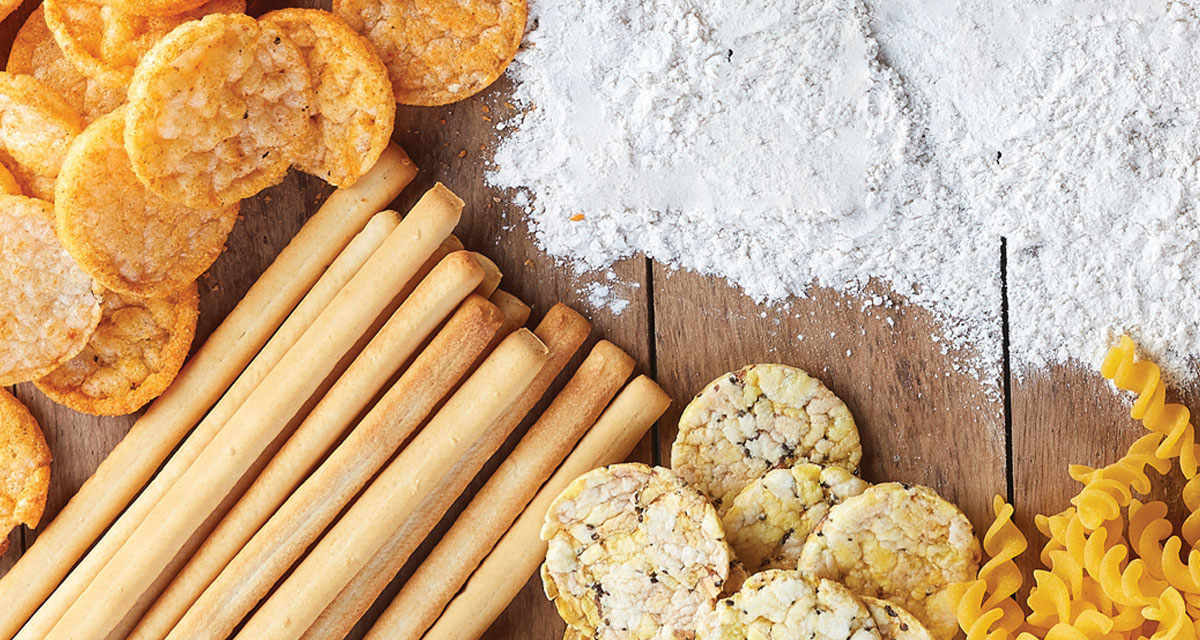Dough makers pound and stretch the dough; then, toss it into the air until it expands in a perfect enlarged circle. Have you ever wondered what compounds create the “elastic” quality? In some grains, such as wheat, barley, rye and spelt, is a protein called gluten, which is essentially flour. One out of 133 people suffer from an autoimmune condition, which makes it difficult to digest gluten. Imagine looking at a menu and realizing few items fit your diet. The “no” column includes any item prepared from flour such as bread or breaded foods, wheat-based pasta, wheat and rye. You too may consider limiting your gluten intake. Fruits and vegetables have a higher nutritional value and can offer the essential vitamins and minerals the body needs!
A MIXTURE OF FLOUR AND WATER
As our proteins of grain mix with water, gluten proteins, such as glutenin and gliadin, form a sticky network comprising a glue-like consistency. It’s understandable why grains are essential to increase the strength, rise and shelf-life of bread and other baked goods. In a body that identifies gluten as a foreign threat, it will quickly attack the lining of the stomach and cause an inflammatory disorder within the small intestines. Eating foods containing similar antigens to gluten is most prevalent with other autoimmune conditions, such as type one diabetes, rheumatoid arthritis, Grave’s disease, Hashimoto’s thyroiditis, celiac disease and irritable bowel syndrome (IBS). As conditions arise, individuals may develop conditions like anemia, osteoporosis, neurological disorders and skin conditions. As to why humans struggle to handle gluten, research believes the digestive system has yet to process high number of grain proteins in today’s foods. According to the National Health and Nutrition Examination Survey, gluten has more than tripled in the past five years.
THE BENEFIT TO AVOIDING GLUTEN
Not choosing to consume breaded and highly processed foods, baked goods and other sugary sweets promote individual health and wellness. Without gluten, most people claim to feel less fatigue and joint pain, and celebrate their weight loss. Open the door to healthy fats – such as fish – and fruits and vegetables. Better filling foods can provide greater essential vitamins and minerals.
THE GLUTEN-FREE WAY
Transitioning to a flour-free diet can impart wonderful techniques to eat better and smarter with the following suggestions!
• Substitute white sugar for organic, raw or brown sugars.
• Cold-pressed oils such as extra virgin olive oils, macadamia nut and grapeseed oils contain high amounts of antioxidants and vitamins; therefore, select over a cooking spray.
• Eliminate using flour and wheat and choose gluten- free, all-purpose and self-rising ours. Rice flour is an ideal substitute, too!
• Use corn flakes as a breading coating on chicken or fish dishes.
• Brown rice has twice the amount of fiber as white rice!
• Go for butter over margarine!
• Find a bakery or recipe book of gluten-free baked goods. Using almond, coconut or hazelnut meal is just as delicious! Give it a try!
• Find a friend who raises chickens, and start consuming free-range eggs.
• Local beekeepers sell raw, unfiltered honey. Be careful of unknown jars that say USDA approved. Most likely, it contains high fructose corn syrup.
• Look for gluten-free products in salad dressings and sauces!
COOKING HEALTHY MEALS
Cookbooks sing the praises of “the weight-loss plan that works for anyone!” Titles such as “4 Ingredients Gluten-Free” by Kim McCosker and Rachael Bermingham, “The Everything Gluten-Free Slow Cooker Cookbook” by Carrie S. Forbes and “The Gluten-Free Edge” by Gini Warner and Chef Ross Harris can help anyone seeking a transition into a new dietary lifestyle. You’ll find delicious recipes to please everyone in the family!
• Fish includes omega-6 fatty acids the body needs. Rather than pasta or French fries, select asparagus and a serving of brown rice with a side of fresh lemon.
• Diners can enjoy a hamburger. Substitute the bun for a crisp leaf of romaine lettuce!
• Potato lovers can create a filling meal with butter and a dash of herbs. Not all restaurants serve scalloped, boiled or roasted potatoes in gluten-free oil.
• Not all restaurants offer gluten-free meals; therefore, take time to question your server to ensure your food selection promotes health and prevents potential bowel discomfort!



















